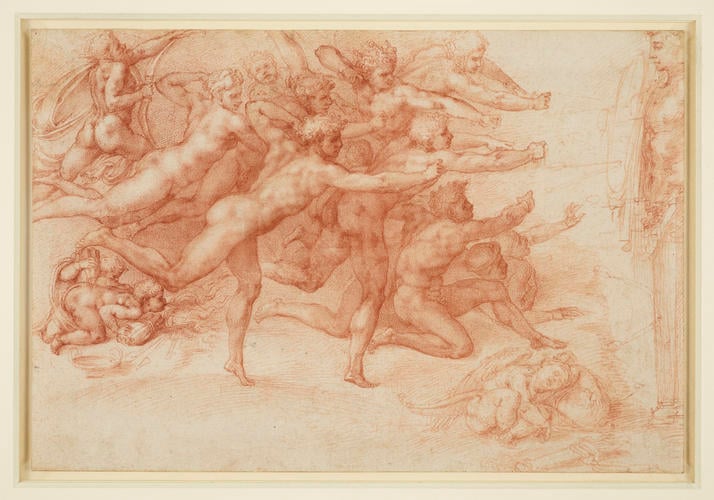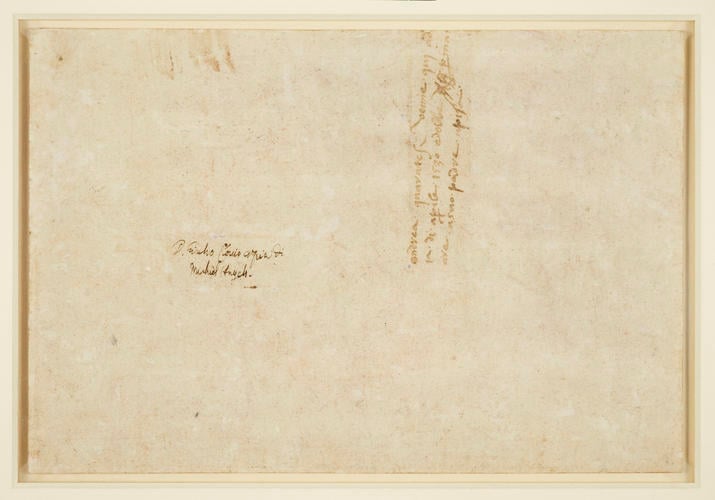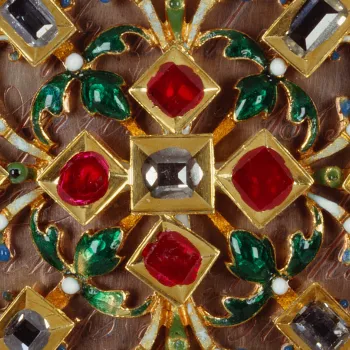Archers Shooting at a Herm c.1530
Red chalk (two shades) | 21.9 x 32.3 cm (sheet of paper) | RCIN 912778
-
A highly finished 'presentation drawing' of a group of archers (mostly without bows), posed as if shooting arrows at a target hung on a herm to the right. A winged cupid sleeps below, while to the left, other putti blow on a fire.
The scene is an indeterminate rocky platform upon which a group of figures, male and female, are posed as if firing arrows at a shield fixed to a herm (a freestanding column with the upper half in human form). Some of the figures, most clearly the woman at the back of the group, are airborne, and most do not bear bows, though arrows are seen stuck into the target and elsewhere on the herm – their aim has been conspicuously awry. At the front of the group two figures sprawl on the ground, and two infants can be seen among the main group. In the right foreground a winged Cupid, god of love, is sleeping with his bow and arrows, while to the far left two children blow on a fire (with arrows protruding from its base) and feed it with bundles of sticks. Michelangelo plays with the contrast between the high polish of the central group and the looser finish of the sleeping Cupid and the herm. But their spatial relationships are unclear or even contradictory, and there is an awkward misalignment between the archers and the herm, which seem to be seen from different angles – Michelangelo’s pursuit of spatial variety over spatial integrity led to an unresolved disharmony.Like Michelangelo's other highly finished drawings in the Royal Collection, the Archers was almost certainly made as a gift for a close friend of Michelangelo, but the recipient is unknown. The conceits depicted – the flames of passion, the arrows of desire – were commonplace in the Renaissance, as they still are, and thus while no direct literary source has been identified, the meaning is plain. As with the pairing of Tityus and Ganymede (see RCIN 912771), Michelangelo distinguishes between two forms of love: base physical lust, and divine love through the contemplation of beauty. The winged Cupid is sleeping and thus unable to guide the archers, for only with love can one achieve one’s target, the soul’s ascent through beauty to the divine sphere. Instead the archers are frenetically impelled by the flames of passion, and their arrows are thus unable to hit their mark. The two children among the group of archers have no interest in firing at the target; a little comically, the old man at upper left is unable even to string his bow (his resemblance to Michelangelo – bearded and with a deformed nose – is probably, but not certainly, unintentional).
On the verso of the sheet are two inscriptions in pen. The first, ‘andrea quaratesi venne quj a di / 12 ap[r]ile 1530 ed ebbe [ducats] 10 p[er] ma[n] / dare a suo padre a pisa’, though not in Michelangelo's hand, refers to a series of payments sent by Michelangelo during the siege of Florence to his aged father in Pisa, through Andrea Quaratesi and his banker father Riniero. This date of 1530 accords well with the style of the drawing on the recto.
The second inscription, 'D. Giulio Clouio copia di / Michiel Angelo', in a late sixteenth-century hand, is more problematic. Taken at face value, it indicates that the drawing was attributed to the miniaturist Giulio Clovio (1498-1578) at an early date, and indeed in the inventory of Clovio’s collection made a few days before his death, a drawing is listed as 'Il saggittario di Michelangiolo fatto da D. Giulio' (‘The Archers of Michelangelo, made by Don Giulio’). A few scholars have accepted the ascription of the drawing to Clovio. But the extraordinary quality of the drawing, the handling of the chalk (both grainy and subtle, unlike the uniform smoothness of all know copies after Michelangelo’s presentation drawings; cf. 913036, a copy by Clovio after Michelangelo’s Ganymede), and the numerous small but significant adjustments to the composition, demonstrate that this is an original drawing by Michelangelo, and indeed one of his finest creations.More loosely, the inscription (and Clovio's inventory) might be taken as proof that the drawing was at least in Clovio's collection at his death in 1578, even if the attribution had become confused (it seems that Clovio was suffering from dementia late in life); the drawings in Clovio's collection were then acquired by Cardinal Alessandro Farnese. But there is some evidence that the drawing was already in Farnese possession by 1572, for a book published in that year, Girolamo Ruscelli's Le imprese illustri, employs the herm and target from Michelangelo's composition to illustrate the imprese (emblem) of Cardinal Alessandro. It may be that the inscription on the verso was due to a later Farnese clerk who, based on his knowledge of Clovio's inventory, mistook Michelangelo's original for a copy of the Archers by Clovio that has since disappeared. (P. Joannides, Michelangelo and his Influence, 1996, no. 16.)
Whatever the drawing's early provenance, it presumably remained in the Farnese collections into the seventeenth century; in the 1640s a volume of 85 drawings supposedly by Raphael and Michelangelo, and '41 different drawings by Michelangelo', were listed in an inventory of Palazzo Farnese. The subsequent route of the drawing into the Royal Collection is unknown; it was in the possession of George III by the end of the eighteenth century, when it was engraved by Francesco Bartolozzi (RCIN 854054), and was presumably acquired by one of George's agents in Rome in the years around 1760.The drawing has been cut down at the edges; its original appearance is probably recorded in the careful copy by Bernardino Cesari also in the Royal Collection (RCIN 990442), made probably while the original was in the Farnese collection. Another careful copy is in the Albertina, Vienna (inv. 39997) with an early attribution to Ambrogio Figino; a pen-and-wash copy is in the Brera, Milan (inv. 585; photo at RCIN 854055).
The drawing was engraved at an early date, in reverse, by Nicolas Beatrizet (RCIN 830387); Beatrizet’s engraving was probably the model for a small fresco of the composition in Villa Borghese.
Provenance
Probably Giulio Clovio (d.1578), from whose estate acquired by Cardinal Alessandro Farnese (d.1589); listed in George III's 'Inventory A', c. 1800-20, p. 45, 'Mich: Angelo Buonaroti' / Tom. II (c. 1802): '2. Men and Women suspended in the Air and shooting Arrows at a / Target fixed on a Term. Cupid a sleep and two Boys / burning his Arrows.- This Emblematical subject is / painted in a {the} Villa {^Orgiati} call'd Raphael's near the Wall of Rome….Red Chalk. {Engraved by Bartolozzio}'
-
Creator(s)
Acquirer(s)
-
Medium and techniques
Red chalk (two shades)
Measurements
21.9 x 32.3 cm (sheet of paper)
Markings
watermark: crossbow in circle, close but not identical with Roberts Crossbow D [watermark]
Object type(s)
Other number(s)











